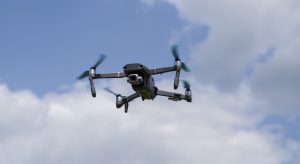Table of Contents
Introduction
If you are a drone enthusiast like I am, you may wonder if you can fly your drone in the wind. You know that flying your drone when it is raining or snowing is not a good idea since it is not waterproof and even likely water-resistant enough to keep moisture out of the engine and battery. However, is it possible to fly your drone in the wind? That depends, and several drones got some testing to see how well they did in windy conditions. Let’s talk about what weather conditions are best to fly your drone so you do not have any repercussions, such as the drone not functioning well after.
How Much Wind Can A Drone Take?
Here is the thing. Even though it is possible to fly your drone in the wind, you have to consider a few things. First, you have to bear in mind the current speed and your drone type. The best thing to remember is that you can fly a drone in winds that are about two-thirds of the maximum speed the drone can fly. For example, if your drone’s top speed is 50 mph, then your drone can handle wind that has a speed up to 33 mph. Any wind speed higher than that will potentially ruin your drone because the rule of thumb is to fly your drone two-thirds of its full speed. Therefore, you want to know how windy outside if you plan to fly your drone. However, there are things you need to know when you plan to fly your drone when it is windy but where it can handle the wind speeds.
How To Fly Your Drone In Windy Conditions
When it is windy outside, you want to know how fast the winds are going so you know whether or not you can fly your drone. If you can fly your drone at the current speed, then there are things you need to prepare. And remember that even if you technically can fly your drone given the current wind speed, that does not mean you should take that chance. It may be best to wait until the winds die down somewhat. You can still ruin your drone or, even worse, put someone in harm’s way if your drone loses its balance from the high winds.
However, if you are not the patient type and want to fly your drone because you can do it even though it is pretty windy, you need to know what preparations to make. The first thing you want to do is stand in front of your drone so you can minimize the impact of the wind before you launch it. That is the time when the drone is most likely to crash because the wind can flip it over or cause it to disappear. In addition, it can cause a crash that would ruin the drone and the propellers if you act as a shield by standing in front of the drone. Therefore, you can minimize the chances of the disaster from happening.
You can also launch the drone around buildings that act as a shield for wind. When your drone takes off, it tilts in the air and appears to fly forward. It does this because it needs to go in the direction of the wind. However, bear in mind that the drone will be noisy as it requires more power when this happens. As you see, there is more work when it comes to flying your drone in highly windy conditions.
There Is An Important Thing To Keep In Mind When The Drone Flies Downwind
When your drone flies downwind, you have to remember to monitor the battery power so you know that there is enough juice so it can fly home. So even though the drone uses less power when it flies downwind, you have to remember it needs enough energy so it can come home. Unfortunately, many people don’t consider that because since it is a known fact that the drone uses less power when it flies downwind, there still may not be enough of it to allow the drone to fly back to you. That is why you must know how much power your drone has.
You Will Want To Fly Your Drone At Lower Altitudes When It Is Windy
Here is something to keep in mind when you are flying your drone. If it is windy, you will want to fly it in lower altitudes. That is because the winds are faster when the height is higher. Therefore, if you fly your drone in very high altitudes, you can lose control of your drone. Even if the winds are two-thirds of your drone’s maximum speed, there are pockets of winds above buildings and hills that are faster than that. And if your drone runs into those pockets, that can destroy your drone. Therefore, if you must fly your drone when it is windy, you want to consider how high to fly it.
Ensure That You Fly Your Drone In Sports Mode
The best thing you can do when you fly your drone in windy conditions is to put your drone in sports mode. That can help limit the drone’s speed, and if you have a DJI drone, all you need to do is go to the app and switch it to sports mode. Other drones should come with instructional manuals and note how to make the switch. However, if the drone travels slowly when it is windy, it is less likely to cause any problems. Also, if your drone goes a little higher and encounters gusty areas, it may prevent any problems!
Conclusion
Can you fly your drone‘ in windy conditions? The answer is yes, but it comes with a caveat. The rule of thumb is to fly your drone when the winds are two-thirds of its maximum speed. However, just because you can technically do it does not mean you should. Winds can still cause it to go out of control and crash and put people and animals in harm’s way. However, if you must do it, then make sure that you shield the drone from the extra wind while taking off by standing in front of it and launching it near buildings. Also, do not fly it at high altitudes because it is windier. Also, please put it on sports mode, limiting the speed. Finally, keep tabs on your battery power. Then you should be OK to go.

